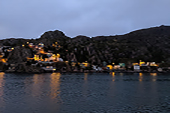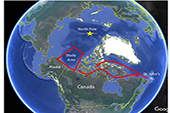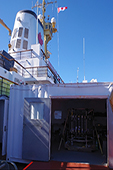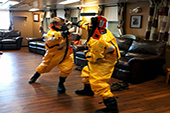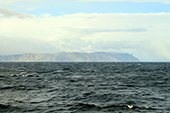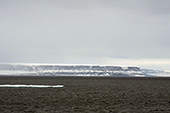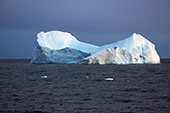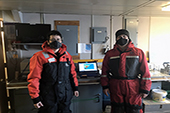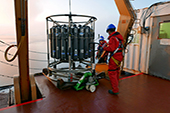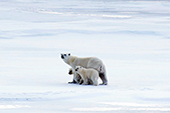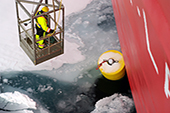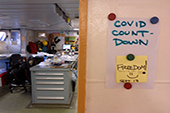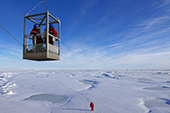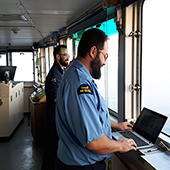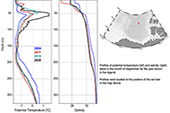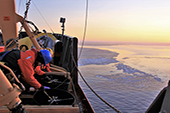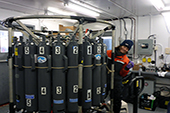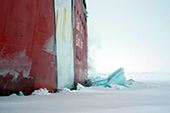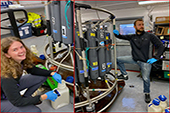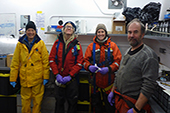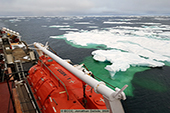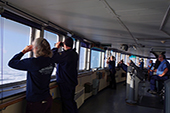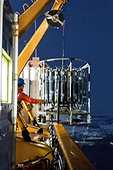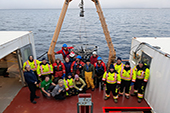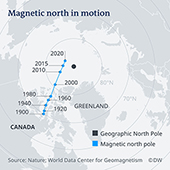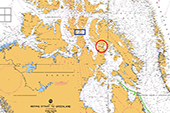2020 Dispatches
Dispatch 1: Departure
Welcome to the 2020 Joint Ocean Ice study (JOIS) dispatches! On Thursday, 15 scientists from within Canada and 57 Coast Guard crew members joined the CCGS Louis S. St-Laurent in the harbor of Saint John's, Newfoundland.
Dispatch 2: Science Plan
We are in St. John’s Newfoundland now, but our goal is the Arctic’s Canada Basin. Once there, we will sample a set of stations from the shallow coastal shelf of North America out through the large deep basin, up to 80 degrees north (600 nautical miles from shore). This will be the 18th year of this impressive time-series.
Dispatch 3: Dear Ol' Rosie: Rosette and Test Cast
As we steam along the Labrador coast, science crew run around "Rosie", our noble niskin bottle and sensor carrying steed (also known as a rosette), changing o-rings, testing springs and hooking lanyards like busy bees all in preparation for the test cast.
Dispatch 4: Scared by the Bell!
My heart raced. A bead of sweat began to materialize on my forehead and I forgot where I was for just a moment. All of this I tried to hide, as I noticed a man who was standing in the hall, just outside of my Supernumerary living quarters. It was one of the crew and he was quite entertained, as he giggled at my reaction to a loud noise.
Dispatch 5: Crossing the Arctic Circle
We crossed the Arctic Circle today! Located at 66°33’ N, this latitude marks the most southerly line where, for at least one day, the sun does not dip below the horizon in the summer now above the horizon in the winter.
Dispatch 6: Traveling throught Talluruptiu-Imanga in Lancaster Sound
As we woke up this morning, we were entering Lancaster Sound. Lancaster Sound sits at the eastern end of Parry Channel, just before it opens up in to Baffin Bay. This area remains open from sea ice for much of the year and is part of the northern hemisphere's largest polynya.
Dispatch 7: Iceberg dead ahead!
"Iceberg dead ahead!" shouts the lookout in the movie Titanic. Everyone knows how that ended, but how did it begin? Where did that iceberg come from and what is an iceberg, anyway?
Dispatch 8: DOM deluge
Dissolved organic matter (DOM) fuels the life of the tiniest creatures in the ocean (stay tuned for more!) which in turn supports the marine food web, all the way up to polar bears. In the ocean, fuel (carbon) sources include plankton that eat CO2, plankton that eat organic matter and organic matter that comes from land. Dissolved organic matter makes up a part of each of these fuel sources.
Dispatch 9: First station
Science has started! Just after supper we arrived at station AG5 in the Amundsen Gulf. The open water and wind combined to create a slight swell, but otherwise it was a pleasant evening. Although we completed a test cast a few days ago, this was our team's first full CTD deployment and we were all excited.
Dispatch 10: The twin cub coincidence
Today we were treated to some of the most special sights of the Arctic: polar bears, and northern lights! We woke up in an area with lots of sea ice and as one of the scientists commented, "this seems like prime territory for polar bears."
Dispatch 11: Recovering buoys from a sea ice fortress
Today we retrieved buoys from the sea-ice that were deployed two years ago about 500 miles to the north. These buoys were done collecting measurements, but continued to transmit their location every hour to help us find them. Due to the strong winds earlier this week, the sea-ice was drifting about 10 miles a day. The hourly updates were needed, especially in the ice-fog to help in this buoy scavenger hunt.
Dispatch 12: Science in the Time of Covid-19
September 17th. The date we had all been anxiously waiting for marked 14 days since the night we all converged on St. John’s, Newfoundland from our various corners of Canada and boarded the Louis S. St- Laurent under a brilliant full moon.
Dispatch 13: ITP Deployment
Twice during the mission, we deployed Ice Tethered Profiler buoys. These buoys, designed by the Woods Hole Oceanographic Institution, are installed on an ice floe and drift with it over several years, collecting oceanographic data.
Dispatch 14: Tools of the (ice) trade
Hello! This summer, my colleague Alexandre and I are the two lucky ice service specialists on duty during the 2020 JOIS mission. Ice service specialists are part of the field division of the Canadian Ice Service. Our main duties on Canadian Coast Guard ships are to collect interpret and distribute ice and weather information.
Dispatch 15: Warm Waters
The latest data coming from the Louis and her team indicate they have encountered some "warm" waters, even as far poleward as 77 degrees North. In recent days, the team has deployed two Ice-Tethered Profilers (ITPs, see www.whoi.edu/itp) which return the measurements that allow us to track and study these warm water
Dispatch 16: 18 years Zooplankton time series
The 18-year Canada Basin zooplankton time series continues! Although the scientific focus onboard is largely physical oceanography and geochemistry, zooplankton sampling has found its place in the JOIS program. Zooplankton are important for nutrient recycling and transfer of energy to higher tropic levels as they form the diet of fish, seabirds, and marine mammals.
Dispatch 17: Labs at Sea
So, what samples do we collect from Rosie, our Niskin bottle carrying steed? As the rosette is brought back up to the surface, bottles are closed at specific depths, capturing the water from that spot. With these samples, we look at the water properties to better understand topics such as circulation patterns, nutrient content, carbon cycling and ocean acidification.
Dispatch 18: Frozen Sea Water
As we make our way across the Beaufort Sea, the air temperature and the number of hours of sunlight per day have been dropping and with that comes the arrival of the new seasonal sea ice. Sea ice differs from icebergs and lake ice in that it is made of frozen sea water rather than terrestrial freshwater.
Dispatch 19: A deep dive into the invisible life of the Arctic ocean
I am Thomas Grevesse, PhD researcher at Concordia University in Montreal. I am teaming up with my lab mate Susan McLatchie. I am from Belgium, a country far from the Arctic, where it rains a lot and it is never too cold. Where Susan is from, on Vancouver Island, is also rainy and mild. We came all the way up to the Arctic to study the incredible diversity of life that we cannot see with the naked eye: bacteria, viruses and microscopic algae, the unrecognized rock stars of the ocean.
Dispatch 20: Barreling through the Barrow Line
After receiving permission from the Alaska Eskimo Whaling Commission in Utqiagvik (Barrow) and the Whaling Captain in Nuiqut, we made our way towards the Barrow Line - a series of eight stations that run up the continental slope towards the northern coast of Alaska.
Dispatch 21: Green water!
As we made our way from the central Canada Basin south towards the Alaskan coast, the water colour transitioned from clear blue to green, then the green faded away and as we neared the coast, it gradually became darker. At the same time the water color changed, the thermosalinograph (TSG) and underway systems started reading out unusual values.
Dispatch 22: Carbon dioxide (CO2) measurements on Ice-Tethered Profilers
Today, we recovered an ITP with a sensor installed that measures the seawater’s carbon dioxide content. Earlier in the program we deployed a similar looking ITP, also with one of these carbon dioxide sensors. Mike DeGrandpre, although not onboard, has sent in a special dispatch describing this sensor and his work.
Dispatch 23: The Mighty Mackenzie Line
The mighty Mackenzie river meanders through Canada’s boreal forests, collecting water from one fifth of Canada’s landmass and pours into the Arctic Ocean. The input of the Mackenzie river is the highest input of river water into the Arctic Ocean from North America. At the start of our last day of sampling, we met up with this river water, under blue skies and surrounded by sparkling ice.
Dispatch 24: The last day of science!
At the reasonable hour of 11 am this morning, the night and day shifts wrapped up the very last station of the Beaufort Sea portion of this trip together. The science is finished!
Dispatch 25: The wandering magnetic North Pole
Although on this cruise, we didn't make it that near the geographic north pole, we were closer to the magnetic north pole (or at least, where it was in 2000)!
Dispatch 26: Bellot Strait
Today we arrived at Bellot Strait just as the morning light started to illuminate the hills. Everyone on the ship was up early taking photos and peering through binoculars. At 1 km wide, this narrow strait is home to many muskox, polar bears, hearty lichens, and whirlpools. The strait was named after the French officer Joseph Bellot who discovered it in the 1850’s during the search for the last Franklin expedition.
Dispatch 27: Baffin Bay
Today started off with thick clouds, some wind, and the occasional few snow flurries (or sleet), like many of the last few days. Our return trip brings us from the Canadian Arctic Archipelago into Foxe Basin and back to St. John's via the Labrador Coast (practically a full circumnavigation of Baffin Island). A narrow passageway (only 2 km wide at its minimum) connects the Gulf of Boothia in the Archipelago with Foxe Basin and eventually to Baffin Bay, although it is wider than Bellot Strait which we passed a couple of days ago.
